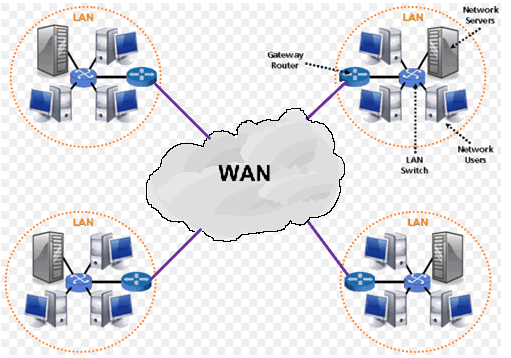What is a WAN?
Wide Area Network (WAN) is a computer network that covers a broad geographical area. On the contrary, Local Area Networks (LAN) are usually limited to a small physical area, like a home, office, building or campus. The largest and most well-known example of a WAN is the Internet. WAN is needed because people or business in remote sites need to be able to communicate and share data. For example, branch offices of an organization want to share the database and company intranet, remote employees or traveling employees want to access information that resides in the corporation network, such as database, confluence, wageworks, etc.
 |
| Wide area network |
WANs are used to connect LANs and other types of networks together. Many WANs are built for one particular organization and are private. Others, built by Internet Service Providers (ISP), provide connections from an organizations’s LAN to the internet. In order to provide connections over large geographical arears, WANs often use public networks, such as the telephone system, leased lines (ISDN), satellite, microwave, or other connection method.
Typical WANs use serial connections of various types to access bandwidth over large geographic areas.
So, who is managing the WANs today? The following organizations defined and managed the WAN access standards:
- International Organization for Standardization (ISO)
- Telecommunications Industry Association (TIA)
- Electronics Industry Alliance (EIA)
WAN access standards are primarily resides in TCP/IP model Link layer or OSI model data link layer and physical layer. WAN access standards describe physical layer and data link layer requirements such as physical addressing, flow control, and encapsulation. The following picture shows the popular WAN solutions today.
 |
| WAN access standards |
As shown above, at OSI model layer 1, WAN protocols describe how to provide electrical, mechanical, operational, and functional connections to the services of a communications service provider.
At OSI model layer 2,WAN protocols define encapsulation of data for transmission toward a remote location and the mechanisms for transferring the resulting frames. The WAN data link layer protocols include:
- HDLC
- PPP
- Frame Relay (Link Access Procedure for Frame Relay [LAPF])
- ATM
 |
| Ethernet WAN, Leased Line, Cable Internet and DSL |
Serial connections support WAN services such as dedicated leased line, above which the PPP or Frame Relay runs.
With fiber optics technology, Ethernet became a reasonable WAN technology. Ethernet cable nowadays can also support long distance communication. 1000BASE-ZX standard, for example, can support 70km cable length, above which Ethernet emulation and Ethernet over MPLS (EoMPLS) protocol runs.
Other WAN services, such as ISDN or dial-up modem, offer low cost dial-on-demand connection. An ISDN BRI is composed of two 64-kbps bearer channels (B channels) for data, and one 16-kbps data channel(D channel) for link-management purposes.
DSL and cable modem connections dominates today’s residential broadband service market. A typical residential DSL service can offer up to 1.5 Mbps connection speed over the existing telephone line. Cable services can offer higher speed connection over the existing coaxial cable TV line.
Well stated, you have furnished the right information that will be useful to everybody. Thank you for sharing your thoughts. Security measures protect your company not only from data breaches, but also from excessive financial losses, a loss of people's trust, and potential risks to brand reputation and future benefits.
ReplyDeleteIT infrastructure services
Cybersecurity Service Provider